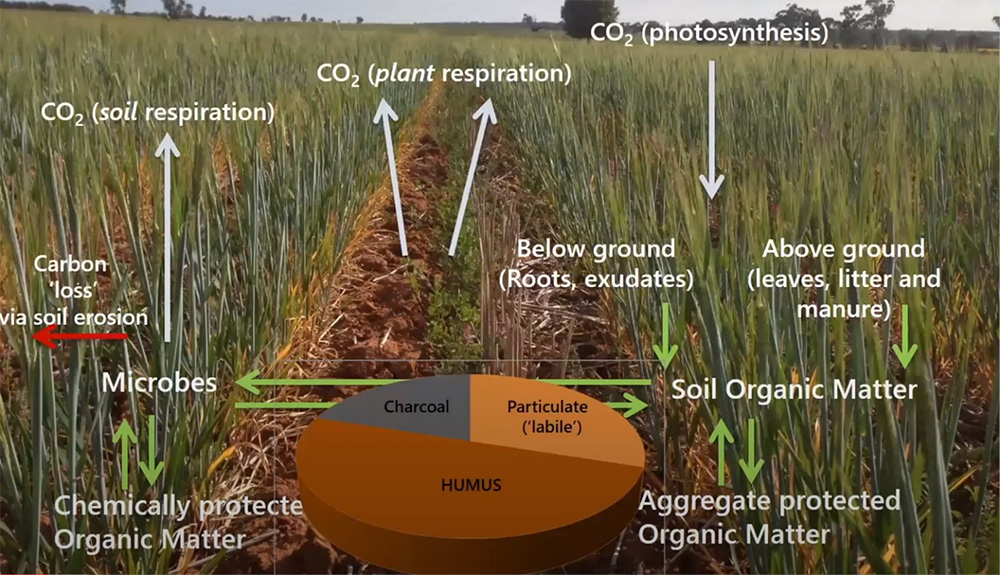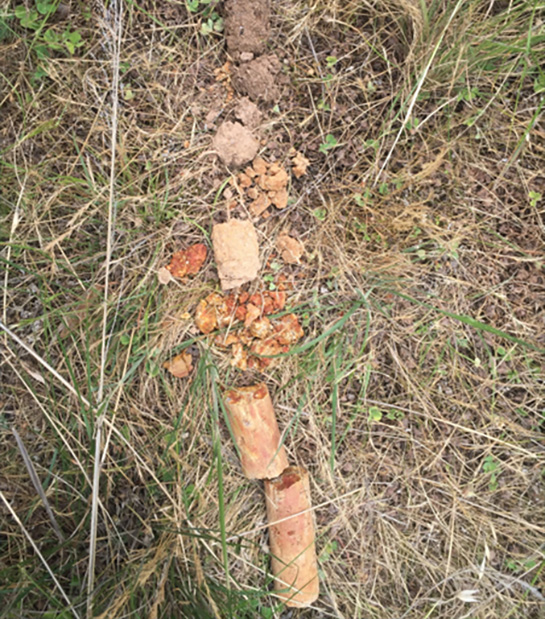A fact sheet to support the Soil CRC’s ‘Soil carbon management and methodologies’ webinar, delivered as part of our ‘Building technical capacity for improved soil management’ webinar series.
In this webinar, Dr Susan Orgill, formerly with NSW Department of Primary Industries (now with Select Carbon) explains:
- how carbon cycles through agricultural landscapes
- the importance of soil carbon
- the differing soil carbon fractions
- how and why to improve carbon sequestration in soil.
Soil organic matter and carbon management
Soil organic matter and carbon management are crucial for sustainable agriculture. Increasing soil organic carbon can enhance nutrient cycling, cation exchange capacity, and water holding capacity, leading to improved productivity and nutrient storage in the soil.
Soil biology and the activity of soil organisms in nutrient provision and carbon cycling play a significant role in plant growth and overall ecosystem health.
Management strategies focusing on maximising biomass production, promoting soil cover, enhancing soil structure, and using diverse rotations or plant species, protect and enhance soil organic matter.
Soil organic matter analysis
Soil organic carbon is the carbon component of organic matter that is measured in soil that passes through a 2 mm sieve. Organic matter (and the carbon it contains) that does not pass through a 2 mm sieve is not sufficiently degraded to be considered as part of the soil organic matter; they are either surface or buried organic residues (DPIRD, WA).
The less than 2 mm fraction in soil organic matter analysis is important for several reasons:
- It provides more accurate and less variable results compared to other fractions.
- This fraction is closely related to soil properties and offers a good indication of active soil organic matter that influences various soil factors.
- Standardising across labs is easier when using the less than 2 mm fraction.
- It includes partially decomposed organic residues, microbes, humus, and charcoal.
Soil organic carbon, the measurable component of soil organic matter, is approximately 58% carbon by weight, with the rest consisting of essential plant nutrients like nitrogen, phosphorus, sulphur, and trace elements.
Factors influencing carbon flow in soil
The type of clay soil, depth, and soil structure play significant roles in modifying the flow of carbon in soil. These factors drive productivity, and while some can be changed through land management practices, others, such as clay content and soil depth, are more challenging to alter. Soil type also influences the amount of carbon in the soil, and different soil types can result in varying carbon stocks.

Flows of soil carbon around the landscape (Orgill, 2020)
Management strategies for soil organic carbon
- Crop to pasture sequence – can increase soil organic carbon composition and productivity in cropping phases. Additionally, introducing cover crops and over-sowing pastures can also help build soil organic carbon. Legumes and grazing animals can contribute to improving soil carbon dynamics, but more research is needed to understand their precise roles.
- Nutrient inputs, minimising tillage, and overcoming soil constraints like acidity through lime and gypsum are other effective strategies.
- Carbon-rich materials such as compost, biosolids, and manures can be added to the soil as amendments to promote soil organism activity and serve as carbon sources.
- Identify and target specific areas for maximum increases in soil organic carbon sequestration, considering soil type and climate factors.
Microbial function and soil carbon
Microbes play a key role in soil carbon cycling. The quality of the carbon source, especially the carbon-to-nitrogen-to-phosphorus ratio, significantly impacts soil biology and carbon storage potential.
Both above-ground (crops and pastures) and below-ground (microbes) biomass need nutrients, water, air and adequate temperature to grow. Most microbes rely on organic matter (crop and pasture residues) as their energy source (i.e. carbon).
Microbes turn over quickly, more than doubling in biomass during a crop season or peak pasture growth with all the tasty roots and root exudates (i.e. carbon), but they need nutrients as well. They get these from the organic matter (but it is generally not enough – think carbon-to-nitrogen-to-phosphorus-to-sulphur ratios in residues), fertilisers, mineral (rock) sources, other microbes and the atmosphere (nitrogen and sulphur mainly).
As their populations grow, die and turnover, humus accumulates in the soil. Humus is dead microbe bodies, excrement and the like, all containing carbon, nitrogen, phosphorus, sulphur, and more. Humus is stable carbon. Nutrients from humus will slowly release fertility to the soil.

Further information
- Soil organic matter in cropping systems (NSW DPI)
- Australian Agriculture in 2020 – Chapter 16 Soil Organic Matter and Carbon Sequestration
- Soil organic matter and carbon sequestration — Charles Sturt University Research Output
- Soil Science Australia smart soil resources
- Soil Quality: 3 Soil Organic Matter (Frances Hoyle & Daniel Murphy) – Available on Apple Books
Relevant Soil CRC projects
- Project 2.1.002 Is the isotopic composition of bulk soil carbon and nitrogen a robust indicator of agricultural soil health?
- Project 4.1.005 Evaluating ecosystems role in increasing soil carbon and soil resilience
- Project 4.1.007 Building soil resilience and carbon through plant diversity.
Acknowledgement
This webinar was recorded in 2020 as part of the ‘Building technical capacity for improved soil management’ webinar series. It was produced by the Soil CRC and jointly funded through the Australian Government’s National Landcare Program.
Posted Mar 15, 2024

